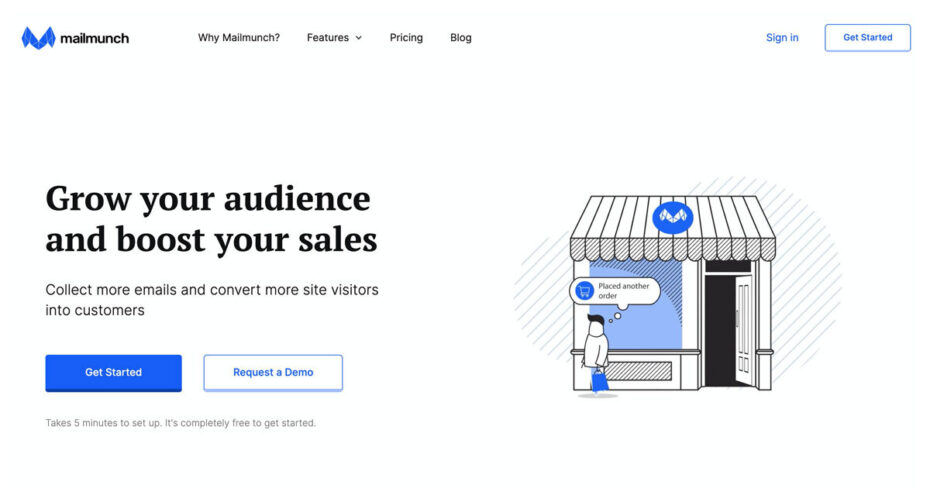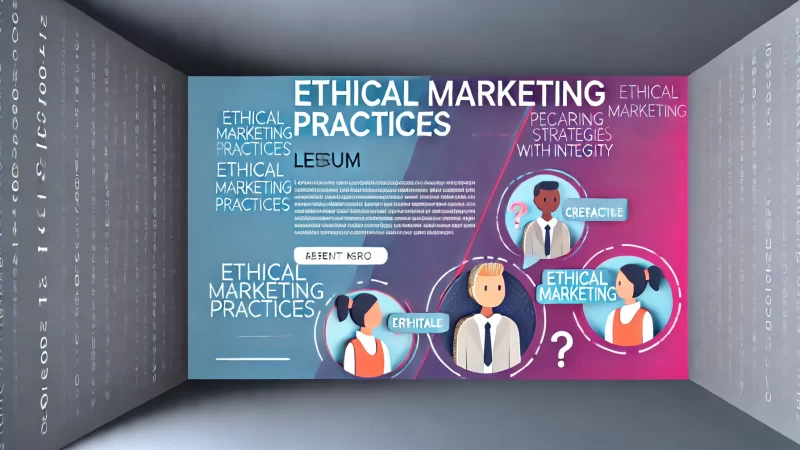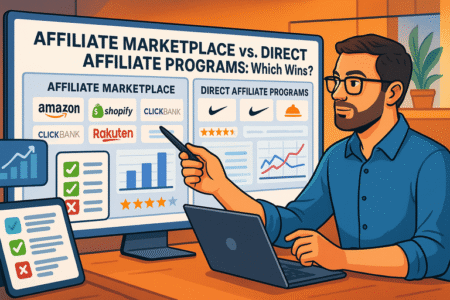Table of Contents
Online affiliate marketing can be a highly lucrative endeavor if approached correctly. By leveraging the right strategies and techniques, you can significantly boost your earnings and achieve long-term success in this competitive field. Here are ten proven tips to help you excel in online affiliate marketing.
1. Master the Basics of Online Affiliate Marketing
Understanding the fundamentals of online affiliate marketing is crucial for anyone looking to succeed in this field. By mastering the basics, you lay a solid foundation that will help you navigate the complexities of affiliate marketing with confidence. This includes learning how affiliate programs work, the roles of affiliates and merchants, and how to earn commissions effectively.
One of the first steps in mastering online affiliate marketing is to familiarize yourself with the various types of affiliate programs available. These can range from pay-per-click (PPC) and pay-per-sale (PPS) to pay-per-lead (PPL) models. Each program has its own set of rules and commission structures, so it’s essential to understand which type aligns best with your marketing goals and audience.
Additionally, understanding key performance indicators (KPIs) such as click-through rates (CTR) and conversion rates can help you track your success and make informed decisions.
Understand Affiliate Marketing Fundamentals
At its core, affiliate marketing involves promoting products or services on behalf of a merchant and earning a commission for each sale or lead generated through your referral. To become a successful affiliate marketer, you need to grasp how this relationship works. This includes knowing how to create compelling content that drives traffic to your affiliate links and understanding the importance of transparency with your audience.
Creating valuable content is a cornerstone of affiliate marketing. This means producing blog posts, videos, or social media content that not only showcases the products you’re promoting but also provides genuine value to your audience. For example, a well-written blog post that reviews a product in detail can help potential buyers make informed decisions. Transparency is also key; always disclose your affiliate relationships to build trust with your audience.
Another fundamental aspect is choosing the right affiliate networks and programs to join. Popular networks like Awin, ShareASale, and CJ Affiliate offer a wide range of products and services to promote. Research these networks to find programs that align with your niche and audience interests. Joining reputable networks can provide you with access to high-quality products and reliable tracking systems, ensuring you get credit for every sale or lead you generate.
Lastly, staying updated with the latest trends and best practices in affiliate marketing is essential. The industry is constantly evolving, with new tools, strategies, and regulations emerging regularly. By keeping yourself informed, you can adapt your approach and stay ahead of the competition. This might involve reading industry blogs, joining affiliate marketing forums, or taking online courses to enhance your skills.
Identify Profitable Niches
Finding a profitable niche is a critical step in your online affiliate marketing journey. A niche is a specific segment of the market that you target with your marketing efforts. Choosing the right niche can significantly impact your success, as it determines the audience you’ll reach and the products you’ll promote. To identify a profitable niche, start by researching market demand and competition.
Begin by exploring various niches that interest you. Passion and knowledge about a particular subject can make it easier to create engaging content. Use tools like Buzzsumo, keyword research tools, and social media insights to gauge the popularity and demand for different niches. Look for niches with a steady or growing interest, as these are more likely to yield long-term success.
Once you have a list of potential niches, evaluate the competition within each one. A niche with high demand but low competition can be a goldmine. Use SEO tools to analyze the top-ranking websites in your chosen niches. Look at the type of content they produce, their audience engagement, and the products they promote. This can give you an idea of what works and help you identify gaps that you can fill with your unique content.
Monetization potential is another crucial factor. Consider the types of products and services available in each niche and their commission rates. Some niches, like technology or finance, often offer higher commissions but may also have more competition. Others, like hobbies or crafts, might have lower commissions but more passionate and engaged audiences. Balance these factors to find a niche that offers both profitability and sustainability.
Finally, test your chosen niche by creating some initial content and promoting it through your channels. Monitor the response and engagement from your audience. If you see positive results, continue to build your presence in that niche. If not, don’t be afraid to pivot and try a different niche. The goal is to find a niche where you can provide genuine value and achieve consistent results.
Choose the Right Affiliate Programs
Selecting the right affiliate programs is essential to maximize your earnings and ensure a successful affiliate marketing career. The right programs should align with your niche, offer competitive commissions, and provide reliable tracking and support. Start by researching different affiliate networks and the programs they offer.
Join reputable affiliate networks that have a wide range of programs relevant to your niche. Networks like Amazon Associates, ClickBank, and Rakuten Advertising are well-known and trusted in the industry. These networks often provide detailed analytics, marketing materials, and support to help you succeed. Look for programs that offer high-quality products and have a good reputation among affiliates.
Consider the commission structure of each program. Some programs offer a flat rate per sale, while others provide a percentage of the sale value. Evaluate which structure works best for your marketing strategy and potential earnings. Also, check the program’s cookie duration, as longer cookie durations increase the chances of earning commissions from repeat visits.
Evaluate the support and resources provided by the affiliate program. Good programs offer marketing materials, such as banners, text links, and product images, to help you promote their products effectively. They should also have a responsive support team to assist you with any issues or questions. Reliable tracking systems are crucial to ensure you receive credit for every sale or lead you generate.
Lastly, read reviews and testimonials from other affiliates to gauge the program’s reliability and effectiveness. Join affiliate marketing forums and communities to get insights from experienced marketers. Their feedback can help you avoid programs with poor support or unreliable payments and focus on those that offer the best opportunities for success.
2. Create High-Quality, Valuable Content

Creating high-quality, valuable content is essential for success in online affiliate marketing. Your content should be informative, engaging, and tailored to your audience’s interests and needs. By focusing on delivering real value, you can build trust with your audience, drive traffic to your site, and increase your affiliate conversions.
One of the key aspects of producing valuable content is understanding your audience’s needs and preferences. This involves conducting thorough research to determine what type of content resonates most with your target demographic.
By addressing their pain points and providing solutions, you can create content that not only attracts but also retains your audience. Additionally, incorporating SEO best practices ensures that your content is discoverable and ranks well on search engines.
Focus on Your Audience’s Needs
Understanding and focusing on your audience’s needs is the cornerstone of effective content creation. To do this, start by defining your target audience. Create detailed personas that outline their demographics, interests, challenges, and goals. This will help you tailor your content to address their specific needs and preferences.
Once you have a clear picture of your audience, conduct surveys and gather feedback to gain insights into their interests and pain points. Use this information to create content that provides solutions to their problems. For example, if your audience is interested in online affiliate marketing, produce content that offers practical tips, case studies, and success stories to help them succeed.
Another important aspect is engaging with your audience through comments, social media, and email. Respond to their queries, ask for their opinions, and encourage discussions. This not only builds a sense of community but also helps you understand their evolving needs. By actively engaging with your audience, you can create content that is highly relevant and valuable to them.
Lastly, continuously analyze your content performance to identify what resonates most with your audience. Use tools like Google Analytics and social media insights to track engagement metrics such as page views, time spent on page, and social shares. This data will help you refine your content strategy and produce more of what your audience loves.
Use Engaging and Relevant Topics
Choosing engaging and relevant topics is crucial for capturing your audience’s attention and keeping them interested in your content. Start by researching trending topics in your niche using tools like Google Trends, BuzzSumo, and social media platforms. Identify what your audience is talking about and interested in, and create content that addresses these trends.
Another effective strategy is to use keyword research tools to find high-volume, low-competition keywords related to your niche. These keywords can help you identify topics that are in demand but not yet saturated with content. By targeting these keywords, you can create content that attracts organic traffic and stands out in search engine results.
Lastly, consider using different content formats to keep your audience engaged. Blog posts, videos, infographics, and podcasts cater to different preferences and help you reach a wider audience. Experiment with various formats to see what works best for your audience and keep your content strategy diverse and dynamic.
Implement SEO Best Practices
Implementing SEO best practices is essential for ensuring your content is discoverable and ranks well on search engines. Start by conducting thorough keyword research to identify the terms and phrases your audience is searching for. Use tools like Squirrly, and Semrush to find relevant keywords with high search volume and low competition.
Once you have your keywords, incorporate them naturally into your content. Avoid keyword stuffing, as it can harm your rankings and readability. Instead, use keywords in your headings, subheadings, and throughout the body of your content in a way that flows naturally. Additionally, include long-tail keywords that are specific to your niche to attract targeted traffic.
Another important aspect of SEO is optimizing your on-page elements. Ensure your meta titles and descriptions are compelling and include your primary keywords. Use header tags (H1, H2, H3) to structure your content and make it easier for search engines to understand. Also, optimize your images by using descriptive file names and alt text that include relevant keywords.
Finally, focus on building high-quality backlinks to your content. Reach out to other websites in your niche and offer to write guest posts or collaborate on content. Share your content on social media and engage with your audience to encourage sharing. High-quality backlinks signal to search engines that your content is valuable and authoritative, which can boost your rankings.
3. Build a Strong Online Presence

Building a strong online presence is essential for success in online affiliate marketing. A robust online presence helps you reach a wider audience, establish credibility, and drive traffic to your affiliate links. By developing a professional website, utilizing social media platforms, and engaging regularly with your audience, you can create a powerful online footprint that supports your marketing efforts.
Your online presence serves as the foundation for your affiliate marketing activities. It allows you to connect with potential customers, showcase your expertise, and provide valuable content that encourages visitors to trust and follow your recommendations. Consistency, authenticity, and strategic planning are key to building and maintaining a strong online presence.
Develop a Professional Website
Creating a professional website is the first step in establishing your online presence. Your website acts as your digital storefront, providing a platform to showcase your content, promote affiliate products, and engage with your audience. A well-designed, user-friendly website can significantly enhance your credibility and attract more visitors.
Start by choosing a clean, responsive design that works well on both desktop and mobile devices. Ensure your website loads quickly, as slow-loading pages can deter visitors. Use high-quality images and graphics to make your site visually appealing. Include easy navigation menus to help users find the information they need effortlessly.
Content is the heart of your website. Create informative, engaging content that provides value to your visitors. Focus on producing high-quality blog posts, product reviews, and tutorials that address your audience’s needs and interests. Use your primary keyword, online affiliate marketing, naturally throughout your content to improve SEO and attract organic traffic.
Optimize your website for search engines by implementing on-page SEO best practices. This includes using appropriate title tags, meta descriptions, and header tags. Ensure your website is structured in a way that search engines can easily crawl and index your pages. Regularly update your content to keep it fresh and relevant, which can help improve your search rankings.
Utilize Social Media Platforms
Social media platforms are powerful tools for building your online presence and driving traffic to your website. By leveraging platforms like Facebook, Twitter, Instagram, and LinkedIn, you can connect with your audience, share your content, and promote affiliate products. Each platform offers unique opportunities to engage with users and expand your reach.
Start by identifying which social media platforms are most popular with your target audience. Create professional profiles on these platforms, using consistent branding elements like logos, color schemes, and messaging. Share a mix of content, including blog posts, videos, infographics, and live streams, to keep your audience engaged and interested.
Engagement is key to success on social media. Respond promptly to comments, messages, and mentions. Encourage discussions by asking questions, running polls, and hosting Q&A sessions. Use social media analytics to track your performance and understand what type of content resonates most with your audience. This can help you refine your strategy and improve your results over time.
Utilize paid advertising options available on social media platforms to boost your reach. Sponsored posts, targeted ads, and influencer partnerships can help you attract new followers and drive traffic to your website. Experiment with different ad formats and targeting options to find the most effective approach for your business.
Engage with Your Audience Regularly
Regular engagement with your audience is crucial for building a loyal community and maintaining a strong online presence. By actively interacting with your audience, you can foster trust, encourage repeat visits, and increase conversions. There are several effective ways to engage with your audience on a regular basis.
One of the most effective engagement strategies is email marketing. Build an email list by offering valuable content, such as free eBooks, newsletters, or exclusive discounts, in exchange for email addresses. Send regular emails to your subscribers, providing them with valuable information, updates, and promotional offers. Personalize your emails to make your audience feel valued and appreciated.
Another way to engage with your audience is through comments and forums. Respond to comments on your blog posts and social media profiles promptly. Participate in relevant forums and online communities where your audience hangs out. Share your expertise, answer questions, and contribute valuable insights. This not only helps build your authority but also drives traffic to your website.
Live interactions, such as webinars, live streams, and online workshops, are highly effective for engaging with your audience. Host live sessions where you can interact with your audience in real time, answer their questions, and provide valuable insights. Promote these events through your website, social media, and email marketing to attract a large audience.
Finally, use feedback and analytics to continuously improve your engagement strategies. Pay attention to what your audience is saying and adjust your content and approach accordingly. Use tools like Hotjar, social media insights, and email marketing software to track engagement metrics and understand what works best for your audience. Regularly refine your strategies to keep your audience engaged and satisfied.
4. Utilize Email Marketing Effectively
Email marketing is a powerful tool in online affiliate marketing that can help you connect with your audience, promote your affiliate products, and drive conversions. By effectively utilizing email marketing, you can nurture relationships with your subscribers, provide valuable content, and increase your earnings. Implementing a strategic approach to email marketing will ensure that your campaigns are impactful and successful.
To make the most of email marketing, focus on growing a high-quality email list and crafting compelling email campaigns. Additionally, tracking and optimizing your email performance will help you refine your strategy and achieve better results over time.
Email Marketing Recommendations
 Aweber
|  Omnisend
|  Mailmunch
|
Grow Your Email List
Building a robust email list is the foundation of successful email marketing. A large and engaged list allows you to reach more potential customers and drive more traffic to your affiliate offers. Start by creating irresistible lead magnets that provide value to your audience, such as eBooks, checklists, or exclusive discounts. Offer these incentives in exchange for visitors’ email addresses.
Promote your lead magnets through various channels, including your website, social media, and paid advertising. Ensure that your sign-up forms are prominently displayed on your website, particularly on high-traffic pages like your homepage, blog posts, and landing pages. Use compelling calls to action (CTAs) to encourage visitors to subscribe to your email list.
Segment your email list based on subscribers’ interests, behaviors, and demographics. This allows you to send targeted and personalized emails that resonate with your audience. For instance, if you have subscribers interested in online affiliate marketing, you can send them specific content and offers related to that topic. Segmentation increases engagement and conversion rates by delivering relevant content to each subscriber.
Leverage social proof to encourage sign-ups. Display testimonials from satisfied subscribers and share statistics about your email list’s growth and engagement. People are more likely to join your list if they see that others find value in your emails. Continuously monitor and refine your list-building strategies to ensure steady growth and high engagement.
Craft Compelling Email Campaigns
Creating compelling email campaigns is essential for engaging your audience and driving conversions. Start by writing attention-grabbing subject lines that entice recipients to open your emails. Use power words, curiosity, and urgency to make your subject lines stand out in crowded inboxes. A well-crafted subject line can significantly increase your open rates.
Inside your emails, focus on providing value to your subscribers. Share informative and engaging content that addresses their needs and interests. For example, you can send educational articles, product reviews, and how-to guides related to online affiliate marketing. Personalize your emails by addressing subscribers by name and tailoring the content to their preferences.
Incorporate visually appealing elements, such as images, videos, and infographics, to make your emails more engaging. Use a clean and responsive design that looks great on both desktop and mobile devices. Ensure your emails are easy to read and navigate, with clear CTAs that guide recipients towards taking action, such as clicking a link or making a purchase.
A/B test different elements of your emails, such as subject lines, content, and CTAs, to determine what resonates best with your audience. Use the insights gained from these tests to optimize your future campaigns. Experiment with different email formats, such as newsletters, promotional emails, and automated drip campaigns, to keep your content fresh and engaging.
Track and Optimize Email Performance
Tracking and optimizing your email performance is crucial for improving the effectiveness of your campaigns. Use email marketing software to monitor key metrics, such as open rates, click-through rates (CTR), conversion rates, and unsubscribe rates. These metrics provide valuable insights into how your emails are performing and where improvements are needed.
Analyze your open rates to determine the effectiveness of your subject lines. If your open rates are low, experiment with different subject line strategies to increase engagement. Similarly, if your CTR is low, review your email content and CTAs to ensure they are compelling and relevant to your audience. High unsubscribe rates may indicate that your content is not meeting subscribers’ expectations, so consider revisiting your content strategy.
Segment your performance data by different subscriber groups to gain deeper insights. For example, analyze how different segments respond to your emails based on their interests, behaviors, and demographics. This information can help you tailor your content and approach to better meet the needs of each segment, resulting in higher engagement and conversion rates.
Regularly review and clean your email list to maintain its quality. Remove inactive subscribers who have not engaged with your emails for an extended period. This helps improve your deliverability rates and ensures that you are reaching an engaged audience. Continuously seek feedback from your subscribers to understand their preferences and improve your email content and strategy.
By focusing on growing your email list, crafting compelling email campaigns, and tracking and optimizing your performance, you can utilize email marketing effectively in your online affiliate marketing efforts. This will help you build strong relationships with your audience, drive more traffic to your affiliate offers, and increase your conversions.
5. Leverage Data and Analytics

Leveraging data and analytics is crucial in online affiliate marketing to understand performance, identify trends, and make informed decisions. By closely monitoring and analyzing data, you can optimize your strategies, increase conversions, and maximize your earnings. Utilizing data effectively allows you to stay ahead of the competition and continuously improve your marketing efforts.
To get started, focus on monitoring your affiliate performance regularly. This will help you understand which strategies are working and where improvements are needed. Additionally, using various tools for data analysis can provide deeper insights into your marketing efforts, enabling you to make data-driven decisions that enhance your overall performance.
Monitor Affiliate Performance
Monitoring affiliate performance is essential for understanding the effectiveness of your marketing campaigns. Begin by tracking key performance indicators (KPIs) such as click-through rates (CTR), conversion rates, and average order value. These metrics provide a clear picture of how well your affiliate links are performing and where adjustments may be needed.
Use tracking software or platforms provided by your affiliate programs to collect data on your campaigns. These tools can show you which products or services are generating the most clicks and conversions, allowing you to focus on promoting high-performing offers. Regularly reviewing this data helps you identify patterns and trends that can inform your marketing strategies.
Set up custom tracking links to monitor the performance of different marketing channels. For example, you can create separate tracking links for your blog, social media, and email campaigns. This enables you to see which channels are driving the most traffic and conversions, helping you allocate your resources more effectively.
Analyze the behavior of your audience by examining metrics such as time on site, bounce rate, and user engagement. Understanding how visitors interact with your content can reveal valuable insights into their preferences and interests. Use this information to optimize your content and improve user experience, ultimately driving higher engagement and conversions.
Use Tools for Data Analysis
Using the right tools for data analysis can significantly enhance your ability to leverage data in online affiliate marketing. Start by incorporating Kissmetrics into your website. This powerful tool provides detailed insights into your website traffic, user behavior, and conversion paths. By analyzing this data, you can identify areas for improvement and optimize your marketing strategies.
Another valuable tool is Sitechecker, which offers comprehensive data on keyword performance, competitor analysis, and backlink tracking. Use Sitechecker to identify high-performing keywords and optimize your content for better search engine rankings. Additionally, analyze your competitors’ strategies to discover new opportunities and stay competitive in the market.
Consider using affiliate network dashboards, such as those provided by Amazon Associates, ShareASale, or CJ Affiliate. These platforms offer detailed reports on your affiliate performance, including clicks, conversions, and commissions earned. Regularly reviewing these reports helps you track your progress and make data-driven adjustments to your campaigns.
Email marketing platforms like Getresponse or ConvertKit also offer robust analytics features. Monitor your email open rates, click-through rates, and conversion rates to understand how your email campaigns are performing. Use A/B testing to experiment with different subject lines, content, and CTAs to determine what resonates best with your audience.
Make Data-Driven Decisions
Making data-driven decisions is key to optimizing your online affiliate marketing efforts. Start by setting clear goals for your campaigns, such as increasing traffic, boosting conversions, or growing your email list. Use the data you collect to measure your progress towards these goals and adjust your strategies as needed.
Regularly review your KPIs to identify areas where you can improve. For example, if your click-through rates are low, consider optimizing your CTAs or experimenting with different ad placements. If your conversion rates are not meeting expectations, review your landing pages and ensure they are user-friendly and persuasive.
Use data to segment your audience and tailor your marketing efforts to different groups. For example, if you notice that certain demographics respond better to specific types of content, create targeted campaigns to address their interests. This personalized approach can lead to higher engagement and better conversion rates.
Finally, stay informed about industry trends and best practices by continuously analyzing your data and conducting research. Join affiliate marketing forums, attend webinars, and read industry blogs to stay updated on the latest developments. By making data-driven decisions and staying adaptable, you can continuously improve your online affiliate marketing performance and achieve long-term success.
6. Diversify Your Income Streams

Diversifying your income streams is a crucial strategy in online affiliate marketing. Relying on a single source of income can be risky, especially in a constantly evolving digital landscape. By spreading your efforts across multiple affiliate programs, marketing channels, and even creating your own products, you can increase your earning potential and reduce financial risk.
To achieve this, start by promoting multiple affiliate programs. This approach ensures that you are not dependent on just one program, which could change its terms or commissions. Additionally, exploring different marketing channels can help you reach a broader audience. Finally, consider offering your own products to further diversify your revenue sources and enhance your brand’s credibility.
Promote Multiple Affiliate Programs
Promoting multiple affiliate programs is an effective way to diversify your income streams in online affiliate marketing. By joining several programs, you can offer a wider range of products and services to your audience, catering to diverse interests and needs. This strategy not only increases your earning potential but also reduces the risk associated with relying on a single program.
Begin by researching and selecting affiliate programs that align with your niche and audience preferences. Look for reputable programs with competitive commission rates and reliable payment terms. Consider joining well-known networks such as MyLead, Fireads, and Flexoffers, which offer a variety of products and services to promote.
Diversify the types of products you promote within your niche. For example, if your niche is health and wellness, you could promote fitness equipment, dietary supplements, and wellness programs. This approach ensures that you have multiple revenue streams and can cater to different segments of your audience.
Regularly review the performance of each affiliate program you are a part of. Track metrics such as click-through rates, conversion rates, and earnings per click. Use this data to identify high-performing programs and focus your efforts on promoting them more heavily. Conversely, if certain programs are underperforming, consider replacing them with new ones that might yield better results.
Explore Different Marketing Channels
Exploring different marketing channels is essential for reaching a broader audience and maximizing your income streams. By leveraging various platforms, you can connect with potential customers in different ways and increase your chances of driving traffic and conversions. This approach helps you tap into multiple revenue streams and reduces the reliance on any single channel.
Start by utilizing social media platforms to promote your affiliate products. Platforms like Facebook, Instagram, Twitter, and Pinterest offer vast audiences and diverse content formats. Create engaging posts, stories, and videos that highlight the benefits of the products you are promoting. Use relevant hashtags, join niche groups, and collaborate with influencers to expand your reach.
Another effective channel is email marketing. Build a robust email list by offering valuable lead magnets such as eBooks, webinars, or exclusive discounts. Send regular newsletters that provide informative content and product recommendations. Personalize your emails to address the specific needs and interests of your subscribers, increasing the likelihood of conversions.
Consider starting a YouTube channel or a podcast to reach audiences who prefer video and audio content. Create informative and entertaining content that showcases your expertise in your niche. Incorporate affiliate links into your video descriptions or podcast show notes, encouraging viewers and listeners to check out the products you recommend.
Lastly, leverage the power of content marketing through blog posts and articles. Write detailed reviews, how-to guides, and listicles that feature your affiliate products. Optimize your content for search engines by using the primary keyword, online affiliate marketing, naturally throughout your articles. This will help you attract organic traffic and increase your chances of earning affiliate commissions.
Consider Offering Your Own Products
Offering your own products is an excellent way to diversify your income streams and establish your authority in online affiliate marketing. Creating and selling your own products allows you to have complete control over your revenue, branding, and customer relationships. This approach can significantly enhance your earning potential and provide additional value to your audience.
Start by identifying a need or gap in your niche that you can fill with your product. Conduct market research to understand what your audience is looking for and how your product can meet their needs. This could be anything from eBooks, online courses, and software tools to physical products like merchandise or branded goods.
Develop high-quality products that reflect your expertise and provide genuine value to your audience. For instance, if you specialize in online affiliate marketing, you could create a comprehensive course that teaches others how to succeed in this field. Ensure your product is well-designed, easy to use, and offers clear benefits to your customers.
Promote your products through your existing marketing channels, including your website, social media, and email list. Highlight the unique features and benefits of your products, using testimonials and case studies to build credibility. Offer special promotions, discounts, or bundles to incentivize purchases and drive sales.
Finally, continuously gather feedback from your customers to improve your products and address any issues. Use this feedback to refine your offerings and ensure they remain relevant and valuable. By consistently providing high-quality products, you can build a loyal customer base and generate a steady stream of income, complementing your affiliate marketing efforts.
7. Optimize Your Conversion Rates

Optimizing your conversion rates is crucial for maximizing the success of your online affiliate marketing efforts. Higher conversion rates mean more sales and commissions from the same amount of traffic, which makes your marketing more efficient and profitable.
By focusing on improving your landing page design, testing and refining calls to action, and reducing friction in the conversion process, you can significantly boost your conversion rates and achieve better results.
To start, ensure that your landing pages are designed to capture the interest of your visitors and guide them towards taking action. Additionally, regularly test and refine your calls to action to see what works best with your audience. Finally, streamline the conversion process to make it as easy and seamless as possible for visitors to complete their purchases or sign-ups.
Improve Landing Page Design
Improving your landing page design is one of the most effective ways to optimize your conversion rates. A well-designed landing page can capture your visitors’ attention and guide them towards taking the desired action, whether it’s making a purchase, signing up for a newsletter, or downloading a resource. Start by ensuring that your landing page is visually appealing and professional.
Use a clean and simple layout that highlights your key message and call to action. Avoid clutter and distractions that could divert the visitor’s attention away from your main goal. High-quality images and videos can help convey your message more effectively and make your page more engaging. Ensure that your landing page is mobile-friendly, as many users access websites from their smartphones.
Focus on creating compelling headlines and subheadings that clearly communicate the value of your offer. Use power words to evoke emotions and encourage action. For example, instead of “Sign Up,” you could use “Get Started Now” or “Unlock Exclusive Benefits.” Your headlines should grab the visitor’s attention and make them want to learn more about your offer.
Incorporate social proof, such as testimonials, reviews, and case studies, to build trust and credibility. Showing that others have benefited from your offer can reassure visitors and increase their likelihood of converting. Additionally, use clear and concise bullet points to highlight the key benefits and features of your product or service, making it easy for visitors to understand the value you provide.
Test and Refine Calls to Action
Testing and refining your calls to action (CTAs) is essential for optimizing your conversion rates. Your CTA is the final step that prompts visitors to take action, so it needs to be clear, compelling, and effective. Start by experimenting with different wording, colors, and placements for your CTAs to see what resonates best with your audience.
A/B testing is a powerful method for optimizing CTAs. Create two versions of your landing page with different CTAs and split your traffic between them to see which one performs better. For example, you could test “Download Now” versus “Get Your Free Guide” to determine which phrase drives more conversions. Use the insights gained from these tests to continuously improve your CTAs.
Consider the placement of your CTAs on your landing page. They should be prominently displayed and easily accessible without requiring visitors to scroll excessively. Placing CTAs above the fold, where they are immediately visible, can increase their effectiveness. Additionally, including multiple CTAs throughout the page can provide visitors with several opportunities to take action.
The design of your CTAs is also important. Use contrasting colors that stand out against the background of your landing page to draw attention. Ensure that the text is large enough to be easily readable and that the button is clickable on all devices. Adding a sense of urgency, such as “Limited Time Offer” or “Only a Few Spots Left,” can encourage visitors to act quickly.
Reduce Friction in the Conversion Process
Reducing friction in the conversion process is crucial for optimizing your conversion rates. Friction refers to any obstacles or inconveniences that make it difficult for visitors to complete their desired action. By identifying and eliminating these barriers, you can create a smoother and more seamless experience that encourages conversions.
Start by simplifying your forms. Long and complicated forms can deter visitors from completing them. Ask only for essential information and use smart forms that auto-fill details where possible. For example, instead of requiring visitors to fill out a lengthy registration form, you could allow them to sign up with their social media accounts or email addresses.
Ensure that your checkout process is straightforward and user-friendly. Minimize the number of steps required to complete a purchase and provide clear instructions at each stage. Use progress indicators to show visitors how far along they are in the process and what steps remain. Offering multiple payment options can also reduce friction and make it easier for visitors to complete their transactions.
Address any potential concerns or objections visitors may have by providing clear and transparent information. Include details about shipping, returns, and security policies on your landing page. Offering a money-back guarantee or free trial can also reduce perceived risk and encourage visitors to take action.
Finally, continuously gather feedback from your visitors to identify areas where friction may be occurring. Use tools like heatmaps, session recordings, and surveys to understand how visitors interact with your landing page and where they may be encountering difficulties. Use this feedback to make data-driven improvements that enhance the overall user experience and boost your conversion rates.
8. Stay Updated with Industry Trends

Staying updated with industry trends is essential for success in online affiliate marketing. The digital landscape is constantly evolving, and keeping up with the latest developments can give you a competitive edge. By staying informed, you can adapt your strategies, leverage new tools and techniques, and stay ahead of your competitors. This approach will help you remain relevant and effective in your marketing efforts.
One effective way to stay updated is by following leading affiliate marketing blogs. These blogs provide valuable insights, tips, and updates on the latest trends and best practices in the industry. Additionally, attending industry conferences and webinars can provide you with firsthand knowledge and networking opportunities. Finally, building connections with other affiliate marketers allows you to share experiences, learn from each other, and stay informed about industry changes.
Follow Leading Affiliate Marketing Blogs
Following leading affiliate marketing blogs is a great way to stay informed about the latest trends and developments in the industry. These blogs are written by experts who share their knowledge, experiences, and insights on various aspects of affiliate marketing. By regularly reading these blogs, you can gain valuable information that can help you improve your strategies and stay ahead of the competition.
Start by identifying some of the top affiliate marketing blogs in the industry. Websites like Affiliate Summit, Smart Passive Income by Pat Flynn, and Neil Patel’s blog are excellent resources. These blogs cover a wide range of topics, including SEO, content marketing, social media strategies, and more. Subscribe to their newsletters or follow them on social media to receive updates on new posts and articles.
In addition to reading blog posts, engage with the content by leaving comments, asking questions, and participating in discussions. This interaction can help you gain deeper insights and connect with other readers who share similar interests. Engaging with the community can also provide you with different perspectives and ideas that you might not have considered.
Use the information you gather from these blogs to experiment with new strategies and techniques. For example, if you read about a new SEO tactic that has proven successful for others, try implementing it on your website to see if it boosts your rankings and traffic. Continuously learning and applying new knowledge will help you stay competitive and improve your online affiliate marketing efforts.
Attend Industry Conferences and Webinars
Attending industry conferences and webinars is another effective way to stay updated with the latest trends in online affiliate marketing. These events bring together experts, influencers, and marketers from around the world to share their knowledge, experiences, and insights. By participating in these events, you can learn about new tools, strategies, and best practices that can enhance your marketing efforts.
Start by identifying reputable industry conferences and webinars that focus on affiliate marketing. Events like Affiliate Summit, Affiliate World, and T&C (Traffic & Conversion) Summit are well-known for their comprehensive sessions and networking opportunities. Register for these events and plan your schedule to attend sessions that are most relevant to your niche and interests.
During these events, take advantage of the opportunity to ask questions and interact with speakers and attendees. This engagement can provide you with additional insights and clarify any doubts you might have. Networking with other participants can also help you build valuable connections and learn from their experiences and successes.
Webinars, in particular, offer the convenience of attending from anywhere, making it easier to stay updated without the need for travel. Many industry experts and organizations host regular webinars on various topics related to affiliate marketing. Keep an eye out for announcements and register for webinars that align with your learning goals.
After attending conferences and webinars, take the time to review and implement the knowledge you gained. Share your learnings with your team or peers and discuss how you can apply these insights to your marketing strategies. This proactive approach will help you stay ahead of industry trends and continuously improve your affiliate marketing efforts.
Network with Other Affiliate Marketers
Networking with other affiliate marketers is crucial for staying updated with industry trends and gaining valuable insights. Building relationships with peers in the industry allows you to share experiences, exchange ideas, and learn from each other. This collaborative approach can help you stay informed about the latest developments and enhance your affiliate marketing strategies.
Join online communities and forums dedicated to affiliate marketing. Platforms like Reddit, Warrior Forum, and various Facebook groups have active communities where marketers discuss trends, share tips, and seek advice. Participate in these discussions by asking questions, offering your insights, and engaging with other members. This interaction can help you build a network of like-minded individuals who can provide support and guidance.
Attend local meetups, workshops, and industry events to connect with other affiliate marketers in person. These face-to-face interactions can lead to deeper relationships and more meaningful exchanges of ideas. Networking events also provide opportunities to collaborate on projects, share resources, and explore new business opportunities.
Consider joining professional organizations and associations related to affiliate marketing. These organizations often host events, webinars, and workshops that can help you stay updated with industry trends. Membership can also provide access to exclusive resources, research, and networking opportunities.
Lastly, leverage social media to connect with other affiliate marketers. Follow industry influencers, join LinkedIn groups, and participate in Twitter chats related to affiliate marketing. Engaging with professionals on social media can help you stay informed about the latest trends, gain insights from experts, and expand your network.
9. Invest in Continuous Learning and Skill Development

Investing in continuous learning and skill development is essential for staying competitive in the dynamic field of online affiliate marketing. By regularly updating your knowledge and acquiring new skills, you can adapt to industry changes, leverage new tools and techniques, and optimize your marketing strategies for better results. This proactive approach will help you stay ahead of the curve and achieve long-term success in your affiliate marketing efforts.
One effective way to invest in your development is by taking relevant courses and certifications. These educational opportunities provide structured learning experiences that can deepen your understanding of affiliate marketing and related fields. Additionally, learning from successful affiliate marketers and keeping up with technological advancements can provide you with valuable insights and practical knowledge to enhance your marketing strategies.
Take Relevant Courses and Certifications
Taking relevant courses and certifications is a great way to enhance your skills and knowledge in online affiliate marketing. Many reputable institutions and platforms offer courses that cover various aspects of digital marketing, including SEO, content creation, social media marketing, and more. By enrolling in these courses, you can gain a deeper understanding of best practices and advanced strategies that can improve your affiliate marketing efforts.
Start by identifying courses that align with your learning goals and interests. Websites like Coursera, Udemy, and LinkedIn Learning offer a wide range of courses taught by industry experts. Look for courses that provide comprehensive coverage of topics relevant to online affiliate marketing, such as keyword research, email marketing, and conversion optimization. Completing these courses can equip you with the skills needed to create effective marketing campaigns and drive better results.
Certifications from recognized organizations can also boost your credibility and demonstrate your expertise to potential partners and clients. For example, the Google Analytics Certification and HubSpot’s Inbound Marketing Certification are highly regarded in the industry. These certifications validate your knowledge and proficiency in specific areas of digital marketing, making you a more attractive candidate for collaborations and partnerships.
Take advantage of free resources as well. Many industry blogs, webinars, and podcasts offer valuable insights and educational content at no cost. Websites like Moz, Neil Patel, and HubSpot regularly publish articles and tutorials that can help you stay updated with the latest trends and best practices. Consistently seeking out and consuming educational content will help you stay informed and continuously improve your skills.
Learn from Successful Affiliate Marketers
Learning from successful affiliate marketers can provide you with practical insights and strategies that have been proven to work in the field. By studying their approaches and understanding the tactics they use, you can apply these lessons to your own affiliate marketing efforts and achieve better results. Follow successful marketers on social media, read their blogs, and listen to their podcasts to gain valuable knowledge and inspiration.
Start by identifying influential affiliate marketers in your niche. These individuals often share their experiences, tips, and strategies through various channels. For example, Pat Flynn, founder of Smart Passive Income, shares his journey and provides actionable advice on building and scaling affiliate marketing businesses. Following his content can help you understand the mindset and strategies of a successful affiliate marketer.
Participate in online communities and forums where affiliate marketers share their experiences and insights. Platforms like Reddit, Warrior Forum, and AffiliateFix have active communities where members discuss their challenges, successes, and strategies. Engaging in these discussions can provide you with real-world examples and practical advice that you can apply to your own marketing efforts.
Consider reaching out to successful affiliate marketers for mentorship or advice. Many experienced marketers are willing to share their knowledge and help others succeed. Building relationships with these individuals can provide you with personalized guidance and support, helping you navigate the complexities of affiliate marketing more effectively.
Finally, learn from case studies and success stories. Many affiliate marketers publish detailed accounts of their campaigns, including the strategies they used and the results they achieved. Analyzing these case studies can provide you with valuable insights and ideas for your own campaigns. By learning from the successes and failures of others, you can refine your approach and achieve better outcomes.
Keep Up with Technological Advancements
Keeping up with technological advancements is crucial for staying competitive in the fast-paced world of online affiliate marketing. New tools, platforms, and technologies are constantly emerging, offering new opportunities to optimize your marketing strategies and improve your results. By staying informed about these advancements, you can leverage the latest innovations to enhance your affiliate marketing efforts.
Start by subscribing to industry newsletters and following technology blogs that cover the latest developments in digital marketing. Websites like TechCrunch, Mashable, and Marketing Land regularly publish articles on new tools, platforms, and technologies. Staying updated with these resources will help you identify new opportunities and stay ahead of the competition.
Attend industry conferences and webinars that focus on technological advancements in marketing. These events often feature presentations and workshops by experts who showcase the latest tools and techniques. Participating in these events can provide you with firsthand knowledge of new technologies and how they can be applied to your affiliate marketing campaigns.
Experiment with new tools and platforms to see how they can enhance your marketing efforts. For example, marketing automation tools like HubSpot and Mailchimp can streamline your email campaigns, while analytics platforms like Google Analytics and SEMrush can provide deeper insights into your performance. Continuously testing and adopting new technologies will help you stay efficient and effective in your marketing efforts.
Finally, engage with the tech community to stay informed about the latest trends and innovations. Join online groups and forums where marketers and technologists discuss emerging technologies and their applications. Networking with professionals in the tech industry can provide you with valuable insights and opportunities to collaborate on innovative projects.
10. Maintain Ethical Marketing Practices

Maintaining ethical marketing practices is essential for building trust and credibility with your audience in online affiliate marketing. By being transparent, honest, and user-centric, you can foster long-term relationships with your audience and ensure sustainable success. Ethical marketing not only protects your reputation but also enhances the overall integrity of the affiliate marketing industry.
To maintain ethical practices, start by disclosing your affiliate relationships. This transparency helps build trust with your audience and ensures that they are aware of your financial interests. Additionally, providing honest and accurate reviews of the products you promote is crucial for maintaining credibility. Finally, prioritize user experience and trust by creating valuable content and addressing your audience’s needs effectively.
Disclose Affiliate Relationships
Disclosing your affiliate relationships is a fundamental aspect of ethical marketing. Transparency about your financial interests helps build trust with your audience and ensures compliance with legal requirements. When you openly disclose your affiliate relationships, your audience can make informed decisions, knowing that you may earn a commission from their purchases.
Include clear and conspicuous affiliate disclosures on your website and in your content. For example, you can add a disclaimer at the beginning or end of your blog posts, videos, and social media posts that informs your audience about your affiliate relationships. Phrases like “This post contains affiliate links, and I may earn a commission if you make a purchase through these links” can help ensure transparency.
Incorporate affiliate disclosures in a way that does not disrupt the user experience. Make sure the disclosure is easily noticeable but does not detract from the content itself. Transparency should enhance, not hinder, your relationship with your audience. By being upfront about your affiliations, you demonstrate honesty and integrity, which can strengthen your credibility.
Regularly review and update your affiliate disclosures to ensure they comply with the latest regulations and guidelines. Organizations like the Federal Trade Commission (FTC) provide guidelines on how to properly disclose affiliate relationships. Staying informed about these requirements and adhering to them can help you maintain ethical marketing practices and avoid potential legal issues.
Provide Honest and Accurate Reviews
Providing honest and accurate reviews is crucial for maintaining credibility and trust with your audience. When you promote products through online affiliate marketing, it’s important to share your genuine opinions and experiences. This authenticity helps your audience make informed decisions and builds long-term trust in your recommendations.
Start by thoroughly researching and testing the products you promote. Use the products yourself, if possible, to gain firsthand experience and insights. Highlight both the strengths and weaknesses of the products in your reviews. This balanced approach shows that you are providing an honest assessment and not just promoting products for financial gain.
Avoid exaggerating claims or making false statements about the products you review. Honesty is key to maintaining your reputation and credibility. If a product has limitations or drawbacks, be upfront about them. Your audience will appreciate your transparency and will be more likely to trust your future recommendations.
Include detailed information and evidence to support your reviews. For example, provide screenshots, photos, or videos of the product in use. Share specific results or outcomes you achieved with the product. This detailed approach adds credibility to your reviews and helps your audience make well-informed decisions.
Encourage feedback and reviews from your audience. Allowing your readers to share their experiences and opinions can provide additional perspectives and enhance the credibility of your content. Engage with your audience by responding to their comments and addressing any concerns or questions they may have about the products you promote.
Prioritize User Experience and Trust
Prioritizing user experience and trust is essential for building long-lasting relationships with your audience in online affiliate marketing. By focusing on providing valuable content and addressing your audience’s needs, you can create a positive experience that encourages loyalty and repeat visits. Trust is the foundation of successful affiliate marketing, and maintaining it should be a top priority.
Create content that is informative, engaging, and relevant to your audience. Understand their needs, preferences, and pain points, and tailor your content to address them effectively. High-quality content that offers genuine value will keep your audience coming back for more and increase their trust in your recommendations.
Ensure your website is user-friendly and easy to navigate. A clean and intuitive design enhances the user experience and makes it easier for visitors to find the information they need. Optimize your website for speed and mobile compatibility, as many users access content from their smartphones. A seamless and enjoyable browsing experience can significantly impact your audience’s perception of your site.
Engage with your audience by responding to comments, emails, and messages promptly. Show that you value their feedback and are willing to help with any questions or concerns they may have. Building a responsive and supportive relationship with your audience fosters trust and demonstrates your commitment to their satisfaction.
Regularly review and update your content to ensure it remains accurate and relevant. Outdated or incorrect information can damage your credibility and trustworthiness. Stay informed about the latest industry trends and developments, and reflect these updates in your content. Continuously improving your content and user experience will help you maintain a loyal and trusting audience.
Frequently Asked Questions (FAQ)
What is online affiliate marketing?
Online affiliate marketing is a performance-based marketing strategy where an individual, known as an affiliate, promotes products or services on behalf of a merchant. The affiliate earns a commission for every sale, lead, or action generated through their referral links.
How do I start with affiliate marketing?
To start with affiliate marketing, you need to choose a niche that interests you, select an affiliate program that fits your niche, create valuable content, and promote your affiliate links. It’s essential to understand your audience and provide solutions to their problems through your promotions.
What are the best affiliate programs for beginners?
Some of the best affiliate programs for beginners include Flexoffers, ShareASale, and MyLead. These programs offer a wide range of products, reliable tracking, and competitive commissions, making them ideal for newcomers.
How can I promote affiliate links effectively?
To promote affiliate links effectively, focus on creating high-quality content that resonates with your audience. Use SEO best practices to improve your content’s visibility on search engines, leverage social media platforms, and engage with your audience regularly to build trust.
What are SEO best practices in affiliate marketing?
SEO best practices in affiliate marketing include conducting thorough keyword research, optimizing on-page elements like meta titles and descriptions, using header tags, and building high-quality backlinks. These practices help improve your content’s ranking on search engines, driving more organic traffic to your site.
How can I track my affiliate marketing performance?
You can track your affiliate marketing performance by using tools like ClickMagic and the analytics dashboards provided by your affiliate networks. Monitor key metrics such as click-through rates, conversion rates, and average order value to assess your campaigns’ effectiveness and make data-driven decisions.
What are the common challenges in affiliate marketing?
Common challenges in affiliate marketing include finding the right niche, creating consistent high-quality content, building an engaged audience, managing multiple affiliate programs, and staying updated with industry trends. Overcoming these challenges requires continuous learning and adaptation.
How much can I earn with affiliate marketing?
Earnings in affiliate marketing vary widely based on factors such as niche, audience size, and the effort put into promotion. Some affiliates earn a few hundred dollars a month, while others make six-figure incomes. Consistency and effective strategies are key to maximizing earnings.
What is the role of content in affiliate marketing?
Content plays a crucial role in affiliate marketing. High-quality, valuable content attracts and engages your audience, builds trust, and encourages them to click on your affiliate links. Types of content include blog posts, reviews, tutorials, and videos.
How can I improve my conversion rates in affiliate marketing?
To improve conversion rates in affiliate marketing, focus on optimizing your landing pages, using compelling calls to action, reducing friction in the conversion process, and continuously testing and refining your strategies based on performance data. Understanding your audience’s needs and preferences is also vital.









